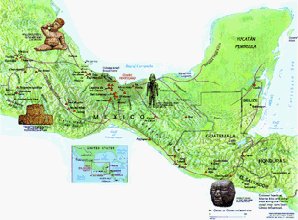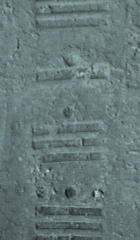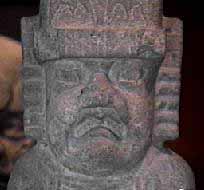
The Olmec Civilization
 The Olmec people referred to themselves as Xi (pronounced Shi). Their main source of food was a result of farming, with the occasional hunting and fishing. It is believed these people spoke a language related to the Mixe and Zoque languages. It is also believed the Olmec people introduced writing to the new world and this early writing consisted of iconography and later evolved into a form of the hieroglyphic system. Some believe the Olmec people were descendants of African immigrants because of the physical characteristics in their monuments and of the consistent signs used in writing were also used by the Vai people of West Africa. They were also considered to be mathematicians and astronomers as represented through their creation of accurate calendars. It is believed the Mayas later adapted the Olmec counting system.  Olmec worship was believed to include at least ten gods, with the earth mother represented by the jaguar, a powerful and feared animal, and the water represented by the serpent. Through Olmec art these gods can be depicted. Their worship included the sacrifice of blood and jade figures to the jaguar. Evidence has shown that the Olmec people also practiced human sacrifice, including the sacrificing of infants.  The Olmec architecture included earthen platform mounds, some with house-like structures built on top and some built around large plaza areas. They also included raised pyramids, ritual centers, and even drainage systems consisting of long U-shaped rectangular blocks of basalt laid end-to-end and covered with capstones. Olmec art included the making of fine pottery, wooden artifacts, carved jade jewelry, and basalt colossal heads and thrones. Several rubber balls and ball courts were also found, implying the Olmec people participated in some form of ball games. The jaguar was found on much of the artwork, especially in that of the human face where the mouth was represented by that of the jaguar; thereby, leading researchers to believe it to be an important symbol of religious and mystical value and that possibly the Olmec mythology believed the human mated with a jaguar. The wooden artifacts consisted of wood, basalt, and jade and are believed to be the oldest found in the Mesoamerica region. The building of colossal heads is believed as way of glorifying the ruler while alive and remembering them after their death. However, much of this monumental art was found damaged or mutilated; so much so, that it lead historians to believe the Olmec people performed this act of mutilation as some form of ritual.  Any trace of this advanced culture for its time is now gone because of the annual flooding and high humidity and heat stemming from the Middle American gulf lands. However, scientists are still hopeful that more will be uncovered over time. This sophisticated Olmec society, as portrayed through their monuments and art, has provided researchers the opportunity to gain knowledge that an advanced society did exist prior to the Maya and Inca civilizations. |
| References: |